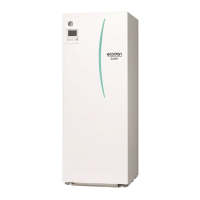
Do you have a question about the Mitsubishi EHST20C-VM2C and is the answer not in the manual?
| Category | Heat Pump |
|---|---|
| Model | EHST20C-VM2C |
| Cooling Capacity | 2.0 kW |
| Indoor Unit Noise Level (Cooling) | 21 dB(A) |
| Manufacturer | Mitsubishi |
| Power Supply | 220-240 V, 50 Hz |
| Outdoor Unit Dimensions (HxWxD) | 550 x 285 mm |
Lists service manuals for outdoor units, referencing specific manual numbers.
Precautions that must be observed to prevent injuries or death.
Precautions that must be observed to prevent damage to the unit.
Lists optional accessories and their part numbers available for the units.
Provides technical drawings and connection details for unit dimensions.
Wiring diagram for specific indoor unit models, detailing connections and symbols.
Details the functions of DIP switches on the FTC printed circuit board for various settings.
Details electrical connections for a single-phase setup where the cylinder unit is powered via the outdoor unit.
Illustrates the water system for split model units, showing connections and components.
Describes the parts and functions of the main remote controller for system operation.
Instructions for initial system setup and settings using the main remote controller.
Details on accessing and navigating the main settings menu for system configuration.
Provides access to advanced functions and settings for installers and service engineers.
Allows adjustments to thermistor readings for accurate temperature measurement.
Configures settings for auxiliary components like pumps, heaters, and mixing valves.
Configures various operational modes including freeze protection, simultaneous operation, and heating.
Displays and configures settings for monitoring energy consumption and heat delivery.
Configures external inputs like demand control and outdoor thermostat for system operation.
Displays current temperature and component data from indoor and outdoor units.
Shows current readings from various thermistors on the water and refrigerant circuits.
Displays current installer and user entered settings for system parameters.
Allows viewing of previous error codes, unit addresses, and occurrence dates.
Protects access to service settings to prevent unauthorized changes by users.
Resets the service menu password to the factory default of 0000.
Restores all system settings to their factory default values.
Describes using an SD card to simplify settings management for the main remote controller.
Lists request codes for accessing indoor unit switch settings and error histories.
Displays the configuration of indoor unit DIP switches based on request codes.
Shows output signal status based on request codes, referencing wiring diagrams.
Displays input signal status based on request codes, referencing wiring diagrams.
Explains how to operate the unit using only the indoor unit without outdoor connection.
Describes emergency operation mode where main control functions are unavailable.
Provides a summary of self-diagnosis based on error codes and service procedures.
Outlines the procedure and checks required before performing a test run of the system.
Explains how to diagnose malfunctions using the main remote controller's error code screen.
Lists error codes, possible causes, and diagnostic actions for troubleshooting.
Provides solutions for faults not indicated by error codes, based on symptoms.
Details how to check the functionality of key components like pumps and heaters.
Illustrates test points on the FTC controller board for troubleshooting electrical issues.
Lists necessary preparations before starting any repair or disassembly work.
Step-by-step guide with photos on how to remove the front panel of the cylinder unit.
Instructions with photos on how to detach the main remote controller from its holder.
Details the process for removing electrical components like breakers, contactors, and terminal blocks.
Step-by-step instructions with photos on removing the control box from the unit.
Guides on removing the primary water pump, pump valve, and strainer valve with photos.
Instructions with photos for removing the 3-way valve and its motor.
Details the procedure with photos for removing the flow sensor from the unit.
Step-by-step guide with photos on how to remove the booster heater assembly.
Instructions with photos for removing the thermostat and immersion heater components.
Guides on removing the P-HEX (Refrigerant-Water) with detailed steps and photos.
Details the process for removing pressure relief valves, manometer, and air vents.
Guides on removing the expansion vessel, including steps for handling flare joints and gaskets.
Instructions for removing the T&P relief valve, specifically for EH*T20*-MHCW models.
Steps for removing the drain cock from the pump valve or pipe side.
Instructions for removing the drain cock from the DHW tank or P-HEX (Water-Water) side.
Details on removing the P-HEX (Water-Water) and associated components like drain cocks.
Guides on removing the sanitary circuit water pump, including electrical and pipe connections.
Instructions for removing the scale trap and its associated components and supports.
Guides on removing various thermistors, including disconnection and holder removal.
Details on how to remove the left and right side panels, including V/M plates.
Instructions for removing the back panel of the unit, including handle removal.
Explains the steps for detaching and attaching quick connections, including O-ring replacement.
Information on refrigerant collection procedures for split model systems.
Details on how the boiler provides back-up operation for heating when the heat pump is unavailable.
Forms for recording system settings and maintenance activities.
Sheet for recording initial system settings and commissioning parameters.
Section for recording routine mechanical and electrical checks for the cylinder unit.
Section for recording routine maintenance checks for the outdoor heat pump unit.
Lists parts requiring regular replacement and their possible failures.
Lists parts needing regular inspection and their possible failures.
Identifies parts that should not be reused after servicing, such as O-rings and gaskets.
